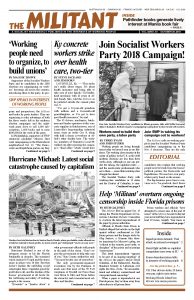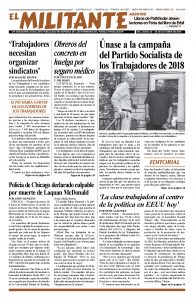President Donald Trump and North Korean leader Kim Jong Un announced they are planning a second summit meeting soon, marking progress in reaching agreement on a formal end to decades of Washington’s hostility to the North and denuclearization of the Korean Peninsula. The first summit was in Singapore in June. The removal of nuclear weapons of all origins from Korea and the surrounding skies and seas would be celebrated by working people in Korea and around the world.
Trump announced the summit plans Oct. 9, two days after Secretary of State Mike Pompeo met with Kim in Pyongyang. This was Pompeo’s second meeting with the North Korean leader to push negotiations forward.
During Pompeo’s visit, Kim invited international inspectors to the Punggye-ri nuclear weapons test site to confirm that “it has been irreversibly dismantled,” the U.S. State Department said. The North Korean government destroyed tunnels at the facility in May. A complete list of all of the North’s nuclear facilities and international inspections confirming the destruction of nuclear sites are among Washington’s demands to advance their denuclearization efforts.
The Democratic People’s Republic of Korea said it is also willing to dismantle its main facility for producing nuclear fuel at Yongbyon if Washington also takes further steps. Pyongyang wants the U.S. government to sign a peace treaty ending the 1950-53 Korean War.
According to numerous press reports, the White House is considering issuing a “symbolic statement” declaring the war is over — instead of signing a treaty. This approach is supported by South Korean President Moon Jae-in, who has been working closely with both parties to advance the negotiations.
Washington has 28,500 troops in South Korea, keeps nuclear-capable planes and ships in the region and continues to impose harsh economic sanctions on North Korea both directly and through the United Nations.
Last year the State Department banned U.S. citizens from traveling to the North, but said it would allow humanitarian exemptions. The Wall Street Journal reported Oct. 11 that the department has rejected requests from at least five groups that provide food and medical aid to the North. The denials are meant to “tighten the screws,” the Journal said, in the face of what U.S. officials claim is “foot-dragging” by Pyongyang. Sanctions like these always hit working people the hardest.
Conflict rooted in U.S. occupation
The U.S. capitalist rulers viewed the opportunity to plunder Asia as a central conquest of their victory in the second imperialist world war. With the connivance of Moscow, Washington divided Korea in half, against the will of the Korean people, after the defeat of Japanese imperialism. Japan’s rulers had occupied and exploited Korea since 1905.
With the defeat of Tokyo, there was a massive resurgence of the fight for Korean independence. Korean workers and farmers disarmed Japanese troops, peasants confiscated large landholdings, and workers committees controlled almost all the Japanese-capitalist-owned factories in the country.
After U.S. troops occupied the South in September 1945, Gen. Douglas MacArthur refused to recognize the newly formed Korean People’s Republic. Instead, he declared that the U.S. Army was the sole government in the South. During the occupation thousands of workers, peasants and revolutionary political activists were arrested, and thousands killed.
The U.S. Army Military Government directly ruled the South until 1948, when it installed the dictatorial regime headed by Syngman Rhee. He remained in power until 1960, when he was forced out by a mass uprising of workers and youth.
The new government in the North, meanwhile, put in place radical reforms in the interest of working people, including a thoroughgoing land reform, expropriation of many capitalist businesses, punishment of Koreans who collaborated with the Japanese occupation, and the passage of laws guaranteeing formal equality for women.
War broke out in 1950 after numerous clashes along the North-South border. With carpet bombing, including use of massive amounts of napalm, the U.S. rulers turned much of Korea into scorched earth.
The U.S. rulers thought they could reimpose the dictatorship of capital in the North. Instead, Korean workers and farmers, with the aid of Chinese volunteers, fought the U.S. forces to a stalemate at the 38th parallel, the first ever military defeat for U.S. imperialism.
Although Washington agreed to an armistice, it has refused ever since to sign a peace treaty formally ending the war. The South Korean government is not permitted to move any people or goods to the North without the approval of the U.S.-run United Nations command, which has been kept in place there since 1953.
SWP: ‘US must sign peace treaty’
“We demand that Washington immediately sign a peace treaty,” wrote Steve Clark for the National Committee of the Socialist Workers Party in a message to the people of the Democratic People’s Republic of Korea on the occasion of their Oct. 10 national holiday. “The U.S. government must call a permanent halt to joint war games with Seoul and lift all sanctions against the DPRK. We demand withdrawal of US troops and weaponry from Korea’s soil, skies, and waters, including, as well, an end to Washington’s ‘nuclear umbrella’ over South Korea and Japan.”
Clark noted that the Socialist Workers Party welcomes “every step since the Singapore summit in June toward an agreement between the DPRK and the US government ensuring a Korea free of nuclear weapons of any origin.”
Progress toward decreasing tensions along the border between North and South, talks being held about large-scale joint industrial and rail development projects, and the reinitiation of reunion programs for families separated since the war point toward the potential for reunification of the country.
“For a nuclear-free Korean Peninsula!” Clark concluded. “Korea is one!”

